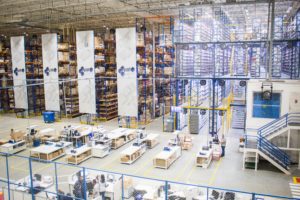
At the rate commerce is growing, the need for faster response times, the ability to manage large numbers of SKUs, and effort to update warehousing to modern-day benchmarks has become more important than ever.
The digital transformation of warehousing is set to affect every supply chain. The days of manual processing and shipping are long gone, and if you’re not willing to take a step towards the future of the industry, chances are you’ll be left behind by competitors willing to invest in innovation.
Here are three ways warehousing is going digital:
Real-Time Data
Probably the biggest advancement to hit our industry is the advent of real-time data processing. Shipments are more connected than ever, and through the use of technological marvels like NFC tags and IoT, or the “internet of things,” warehouses are able to keep track of every piece of inventory as it enters and leaves the facility.
The warehouses and supply chains of the future will prioritize interconnectivity, with every piece of equipment being given its own unique digital signature with which to communicate with other devices. This will give organizations unparalleled levels of control over their inventory, and the most accurate data possible.
Warehouse Mobility
Another way warehouses are going digital is the way they’re creating mobility solutions for employees walking the floor. In the past, accessing information would mean that someone would need to sit down at a desktop and look up whatever solutions they needed. This greatly hindered operational efficiency and increased walk times for team members.
Today, technological advancements in the form of smartphones and mobile apps have dramatically increased warehouse mobility. They give workers the flexibility to perform at their best, providing computational power at their fingertips so that they can spend less time on deskbound activities and more time finding answers.
Automation and Robotics
What’s guaranteed to be a game-changer for warehouses over the next few years is the further adoption of automation technology and robotics within the supply chain. Through the use of advanced programming methods and machine learning, warehouses are becoming more connected each and every day. Automation and robotics provide the promise of lower overhead costs as the need for manual labor gets replaced by more functional pieces of equipment that can simplify performance and increase efficiency.
Furthering these capabilities with the use of artificial intelligence, robots are able to learn on the go and refine processes in ways that were previously unimaginable. The truth is, robotic technology has created human-like pieces of machinery that can sense, adapt to, and remember complicated tasks better than their predecessors.
Improve Your Warehousing With Pyramid Logistics
Looking for effective worldwide tradeshow and specialty transportation services that are responsibly priced, timely, efficient, damage-free, and in conformity with the highest industry standards? Pyramid logistics utilizes cutting-edge technology to provide your team with the warehousing capabilities of the future. As the industry continues to go digital, Pyramid Logistics remains at the forefront of warehousing, implementing some of the very technologies we mentioned in this article.
If you’d like to learn more about partnering with us, click here.
